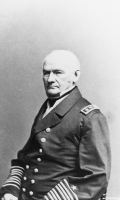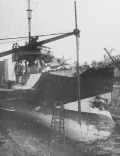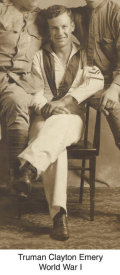Click On Image
For Full Size Image |
Size |
Image Description |
Contributed
By And/Or Copyright |
Namesake
|
 |
229k | Rear Admiral Hiram Paulding, USN (Retired) photograph taken circa 1864-1866 by J. Gurney & Son, New York City. The original print was mounted on a carte de visite. Naval History & Heritage Command photo NH 88388. | Tony Cowart |
USS Paulding (Destroyer No. 22)
|
 |
133k | Undated at Boston. Photo from Leslie Jones Collection, Boston Public Library. | Ed Zajkowski |
 |
166k | Undated at Boston USS Henley (Destroyer No. 39), USS Paulding (Destroyer No. 22) and USS Fanning (Destroyer No. 37). Photo from Leslie Jones Collection, Boston Public Library. | Mike Mohl |
 |
110k | Circa 1914, location unknown. Library of Congress Prints and Photographs Division. Photo # LC-DIG-hec-04923. | Tom Kermen |
 |
175k | Circa 1914, location unknown. Library of Congress Prints and Photographs Division. Photo # LC-DIG-hec-04924. | Tom Kermen |
 |
125k | USS Paulding (Destroyer No. 22), USS Ammen (Destroyer No. 35) and USS Jouett (Destroyer No. 41) at Philadelphia Navy Yard. Photo from Philadelphia Evening Ledger, 03 February 1917. | Mike Mohl |
 |
130k | Checking the Anti-Aircraft battery at Boston Navy Yard on May 21, 1917. Library of Congress Prints and Photographs Division. Photo # LC-DIG-npcc-32890. | Tom Kermen |
 |
549k | Port side, camouflaged, Queenstown, Ireland, 1918. Naval History & Heritage Command photo NH 42809 | Dave Wright |
 |
360k | USS Paulding (Destroyer No. 22) standing by near a small boat, in the vicinity of Queenstown, Ireland, 1918. Army Signal Corps Collection photo 111-SC-6872, now in the U.S. National Archives. | Tony Cowart |
 |
749k | USS Paulding (Destroyer No. 22) in drydock at Queenstown, Ireland, while receiving repairs to her bow, 1918. Naval History & Heritage Command photo NH 42810
| Tony Cowart |
 |
741k | USS Paulding (Destroyer # 22) drydocked for repairs at Queenstown, Ireland, 1918. Her bow appears to have suffered collision damage. Naval History & Heritage Command photo NH 42811 | Tony Cowart |
 |
51k |
Electrician Truman Clayton Emery served aboard USS Paulding (Destroyer #22) during World War One. Photos courtesy Clayton Emery, Truman C. Emery's grandson. |
Clayton Emery |
 |
31k |
 USCGC Paulding (CG-17) USCGC Paulding (CG-17)
|
 |
122k | USCGC Paulding (CG-17) underway, location unknown. Note that she has retained the "North Atlantic" front to the bridge structure. Photo USCG from "An Illustrated History of Destroyers of The World" by Bernard Ireland. | Robert Hurst |
 |
33k | Undated, on Coast Guard service during the Prohibition Era. Official USCG photo. | Mike Green |
 |
26k | On Coast Guard service during the Prohibition Era with seized rum runner alongside. Official USCG photo. | Mike Green |
 |
133k | Port side view of the USS Paulding (CG-17) on the Marine Railway at the Boston Navy Yard, Charlestown, Massachusetts, 24 December 1927.
Leslie Jones Collection, Boston Public Library. | Mike Green |
 |
111k | USCGC Paulding (CG-17) on the Marine Railway at the Boston Navy Yard, Charlestown, Massachusetts, 26 December 1927, showing damage to her bow from her collision with USS S-4 (SS-109) on 17 December 1927. Naval History & Heritage Command photo NH 69120, courtesy of the San Francisco Maritime Museum, San Francisco, California, 1969. | Tony Cowart |
 |
168k | Circa 1924-1930 on Coast Guard service. (L-R) USS Jouett (CG-13), USS Paulding (CG-17) and USS Beale (CG-9). Leslie Jones Collection, Boston Public Library. | Ed Zajkowski |
 |
157k | The Coast Guard destroyers USCGC Tucker (left) and USCGC Paulding (right) sit moored side-by-side at Provincetown, MA, 18 December 1927. The previous day, USS S-4 (SS-109) was running submerged just off Provincetown, conducting speed and maneuverability tests when it was struck by Paulding. The stricken sub with two holes (one in a ballast tank and one in the pressure hull) begin sinking as the freezing water flooded into the boat, causing her to heel to port and begin to sink by the bow. Paulding’s crew immediately marked their position on a chart and radioed their superiors. When the destroyer came to a halt, one of her lifeboats was lowered over the side. All it found was a small oil slick, which the men aboard marked with a buoy. | Bill Gonyo |

